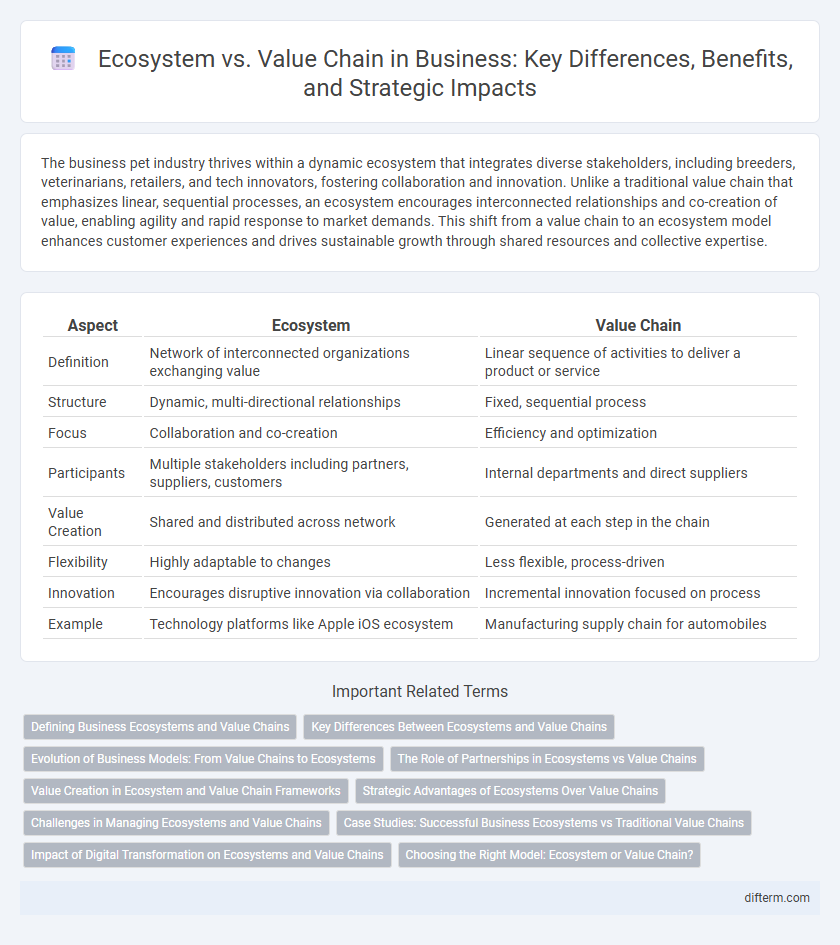The business pet industry thrives within a dynamic ecosystem that integrates diverse stakeholders, including breeders, veterinarians, retailers, and tech innovators, fostering collaboration and innovation. Unlike a traditional value chain that emphasizes linear, sequential processes, an ecosystem encourages interconnected relationships and co-creation of value, enabling agility and rapid response to market demands. This shift from a value chain to an ecosystem model enhances customer experiences and drives sustainable growth through shared resources and collective expertise.
Table of Comparison
| Aspect | Ecosystem | Value Chain |
|---|---|---|
| Definition | Network of interconnected organizations exchanging value | Linear sequence of activities to deliver a product or service |
| Structure | Dynamic, multi-directional relationships | Fixed, sequential process |
| Focus | Collaboration and co-creation | Efficiency and optimization |
| Participants | Multiple stakeholders including partners, suppliers, customers | Internal departments and direct suppliers |
| Value Creation | Shared and distributed across network | Generated at each step in the chain |
| Flexibility | Highly adaptable to changes | Less flexible, process-driven |
| Innovation | Encourages disruptive innovation via collaboration | Incremental innovation focused on process |
| Example | Technology platforms like Apple iOS ecosystem | Manufacturing supply chain for automobiles |
Defining Business Ecosystems and Value Chains
Business ecosystems consist of interconnected organizations, technologies, and stakeholders collaboratively creating value through shared resources, innovation, and adaptive relationships. Value chains represent a linear sequence of activities or processes where each step adds incremental value to a product or service, often controlled by a single company. Understanding the distinction highlights ecosystems' dynamic, network-driven interactions versus value chains' structured, sequential value creation.
Key Differences Between Ecosystems and Value Chains
Ecosystems encompass a dynamic network of interconnected businesses and stakeholders collaborating to create mutual value through innovation and adaptability, while value chains focus on sequential, linear processes adding value at each stage of production and distribution. Ecosystems emphasize co-creation, interdependence, and external partnerships, whereas value chains prioritize internal efficiency, control, and cost optimization within a defined set of activities. The key differences lie in the scope of relationships, flexibility, and focus on innovation versus operational excellence.
Evolution of Business Models: From Value Chains to Ecosystems
Business models have evolved from traditional value chains, characterized by linear, sequential processes, to dynamic ecosystems that foster collaboration among diverse stakeholders. Ecosystems enable companies to co-create value through interconnected networks, leveraging shared resources and technologies for greater innovation and agility. This shift enhances competitive advantage by emphasizing adaptability and interdependence rather than isolated efficiency and control.
The Role of Partnerships in Ecosystems vs Value Chains
Partnerships in ecosystems involve dynamic, multi-directional collaboration where businesses co-create value across interconnected networks, enhancing innovation and adaptability. In contrast, value chain partnerships are typically linear and transactional, focusing on efficiency and cost reduction within a defined sequence of activities. Ecosystem partnerships drive competitive advantage through shared resources and flexible roles, while value chain alliances emphasize optimizing specific links in a production or distribution process.
Value Creation in Ecosystem and Value Chain Frameworks
Value creation within ecosystem and value chain frameworks diverges significantly, as value chains emphasize linear, sequential processes connecting suppliers, manufacturers, and customers to optimize efficiency and cost reduction. Ecosystems generate value through dynamic interactions among diverse participants--such as partners, competitors, customers, and technology providers--enabling innovation, co-creation, and flexible adaptation to market changes. This integrative collaboration enhances collective value beyond the capabilities of any single entity, fostering sustainable competitive advantages and expanding overall market opportunities.
Strategic Advantages of Ecosystems Over Value Chains
Ecosystems foster dynamic collaboration among diverse stakeholders, enabling faster innovation and adaptation compared to traditional value chains. By leveraging network effects and shared resources, ecosystems create scalable opportunities that enhance competitive advantage and market responsiveness. This interconnected structure supports continuous value creation beyond linear supply chain limitations, driving sustainable growth and resilience.
Challenges in Managing Ecosystems and Value Chains
Managing ecosystems involves navigating complex interdependencies among diverse stakeholders, which can lead to coordination challenges and misaligned incentives. Value chain management often struggles with optimizing efficiency while maintaining flexibility in supplier relationships and adapting to market fluctuations. Both require continuous communication, transparency, and strategic integration to mitigate risks and drive sustainable growth.
Case Studies: Successful Business Ecosystems vs Traditional Value Chains
Successful business ecosystems, such as Apple's App Store and Amazon's Marketplace, demonstrate dynamic interactions among diverse participants generating exponential value beyond linear transactions typical of traditional value chains. Case studies reveal ecosystems foster innovation, scalability, and resilience by leveraging network effects and co-creation among partners, whereas traditional value chains emphasize optimized, sequential processes for cost efficiency. Companies like Alibaba illustrate how ecosystems accelerate market expansion by integrating suppliers, customers, and third-party services into a seamless platform, contrasting with manufacturing-centric value chains focused on production and distribution efficiency.
Impact of Digital Transformation on Ecosystems and Value Chains
Digital transformation reshapes business ecosystems by enabling real-time data exchange and fostering collaboration among diverse stakeholders, thereby enhancing innovation and agility. Traditional value chains evolve into interconnected digital networks where automated processes and analytics optimize efficiency and customer value. This shift drives companies to integrate platforms and leverage digital technologies, transforming linear value chains into dynamic ecosystems with expanded competitive advantages.
Choosing the Right Model: Ecosystem or Value Chain?
Choosing the right business model--ecosystem or value chain--depends on the company's strategic goals and market dynamics. Ecosystems emphasize collaboration among diverse partners to co-create value through interconnected platforms, fostering innovation and adaptability. Value chains focus on a linear process of production and delivery, maximizing efficiency and control within a defined sequence of activities.
Ecosystem vs Value Chain Infographic

 difterm.com
difterm.com